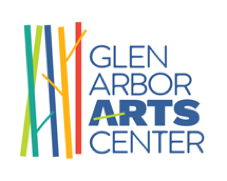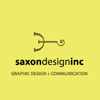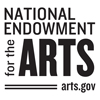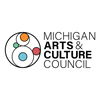
Creativity Q+A with Royce Deans
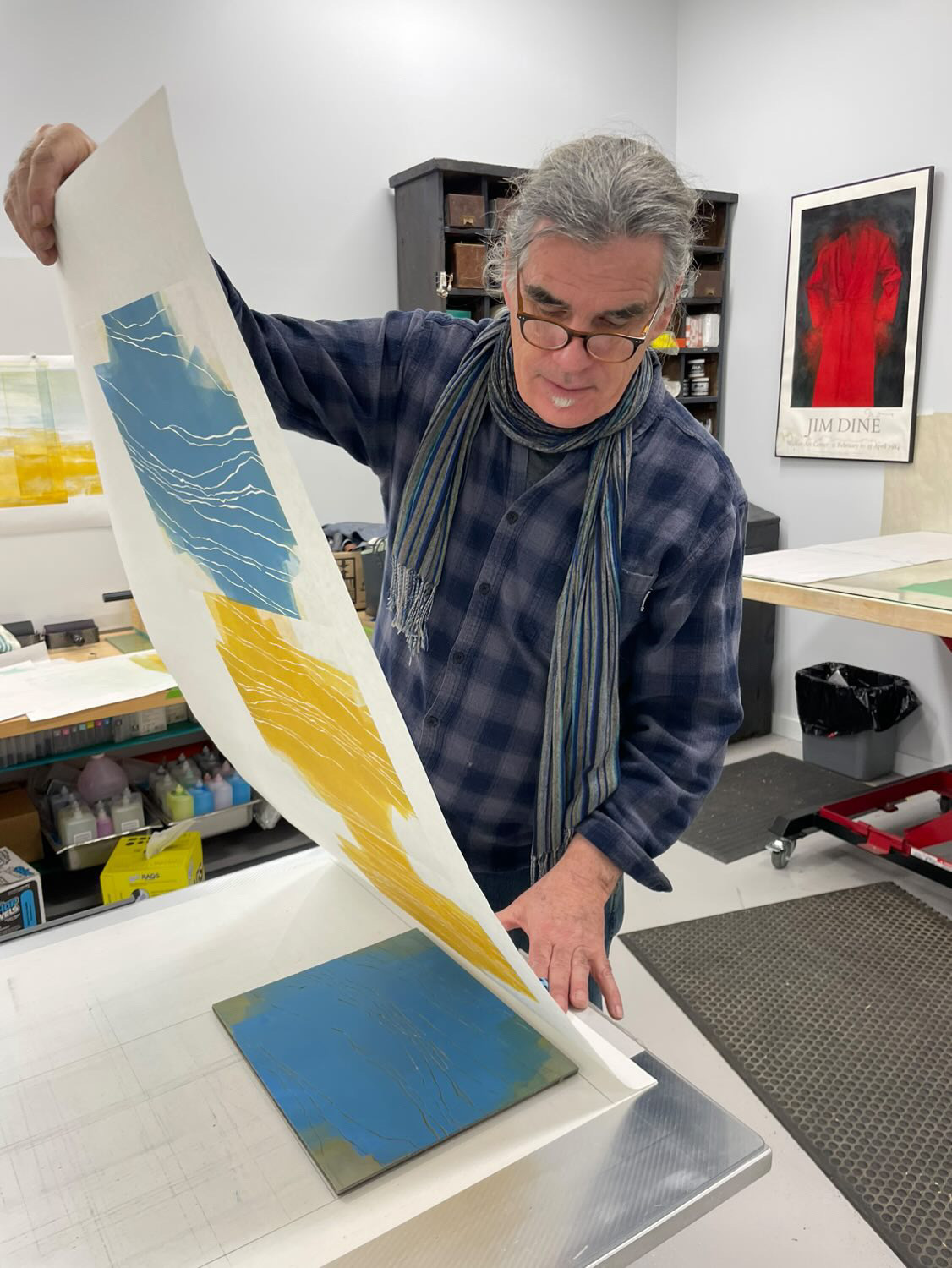
Royce Deans’s creative life has been a “crooked trail” of work in graphic design, and illustration — a not-so-straight path toward a process-driven practice focused on painting and printmaking. “I’ve identified as a painter even before I got out of art school,” Royce, 66, said. He lives in Traverse City, Michigan, and is a well-known maker and teacher in the region’s creative community; but it wasn’t always that way. “I was almost 30 when I figured out that you could be an artist. That that exists,” Royce said. He was, he said, a “late bloomer.” This interview was conducted in February 2023 by Sarah Bearup-Neal, GAAC Gallery Manager, and edited for clarity.
You work in many media.
I am a multi-disciplinary artist. I’ve been a painter exclusively for the past 35 years. About five years ago, I picked up printmaking. And since August, I’ve only been printmaking — as well as developing into a burgeoning poet. But I don’t consider printmaking a different discipline than painting. It’s just another way of making visual art.
Talk about the transition from being, primarily, a painter to making visual art through printmaking.
It’s something I think about a lot — in my own work and when I’m teaching — solving creative issues by coming at it all from a different perspective. If I come at the same subject through printmaking, it pushes my brain to find new solutions that I wasn’t expecting. It’s like the exercise of writing or drawing with your non-dominant hand.
Is it the tools? That materials? The end result that has that effect of pushing your brain into a different place?
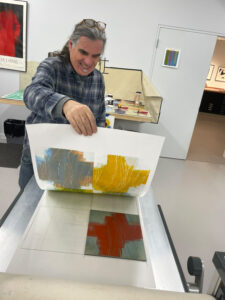
When I started making these monotypes, I started working on Plexiglass plates, and trying to do my paintings on the Plexiglass plates. That alone was enough to be interesting because of the different types of marks I could get. There’s a whole, new set of marks you can get with printmaking. It’s something I can’t achieve with painting.
Another thing that intrigues me about printmaking is I can work for hours on a plate — whether inking a mono type plate or cutting and inking a linoleum block — repeating the same process over and over, and there’s still so many variables left to explore: pressure of the press, what paper I’m using, humidity of the studio, or maybe I’m not paying attention and you print something upside down. There are so many things that could happen. Working without a net is exciting.
Did you receive any formal training in visual art?
I went to the American Academy of Art in Chicago [1980-83]. In some ways it was good. There was a lot of time spent on fundamentals of design and composition, which play into the way I approach a painting. I think most of the great painters throughout history have been great designers, too. I received an Associate’s Degree in Design and Illustration. After that I hit the pavement and started doing design work for agencies in Chicago.
Tell me about your studio.
My studio is located south of Cedar [Michigan]. It’s in a big 40 ft. x 50 ft pole building on a [50-acre compound and residential-farm collective]. I have a space where I can spread out and work. There are expansive views outside my windows, and I do look out of them.
How does this space facilitate your creative work?
The whole environment on this compound is super good for me. Nature is everywhere. The place feels nurturing to me every time I walk in the door. A studio is so important for artists, to have a place to make your mess and be able to come back to your mess the next day, and know it’s not going to be bothered. The owners of the place are wonderful patrons of the arts and good friends too.
That’s a lot of square footage. I’d imagine there’s a correlation between how much space you have and what kind of work you do.
Yes. It’s got a big, overhead, 10-foot door. I could drive a semi into it. I can do big work work if I want in the space.
What are the themes/ideas that you focus on in your work?
I’m an observationalist. The end result of my work may be abstracted or stylized, but none of it comes out of my imagination. It’s all from observation of nature, the landscape, the figure. The place we live in here is a huge inspiration to me. The texture of the water’s surface, or the bottom of the lake or the contours of the hills, they all play into the motifs that I find myself returning to over and over again. I’ve always had a strong interest in incorporating the figure into my work.
Why is the figure a subject of so much interest to you?
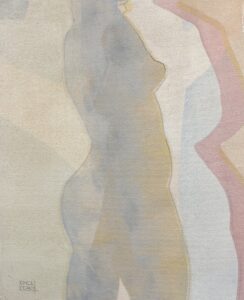
I’m fascinated with the shapes and forms and balance and composition possibilities that the human form gives us. I’m really interested in people, and people all have bodies, and it all weaves together to hold my interest.
You’ve been running figure drawing sessions in your studios for years.
With the advent of COVID and the pandemic, I switched over to doing them online for the last three years.
The model is there in your studio?
No. The model is somewhere else, in their own home or studio.
.And anyone who takes the class draws from their computer screen?
Again, coming for the illustration background where all you work from is photographs — when I started doing what I’m doing as a fine artist, working from photographs … It’s such a thing for me to be in close proximity to the three-dimensional experience, so working from photographs and the screen: I had my doubts; but it has ended up being fabulous. Socially, during the pandemic, it was good to bring people together on a weekly basis. For me, I got used to the idea. What helped my drawing was everybody works with some sort of different computer or phone. All these have a different camera, and all the models have different set-ups. I realized the nature of what I’m providing is, in many ways, distorted by the lens, and once I just drew what I saw — not what I think I know — I got better. After doing that for a couple years, when I did draw from the figure live again, I was a little bit nervous that I’d ruined myself working from the computer screen. And, I found that I could draw better. It was an interesting surprise I was really pleased about.
What prompts the beginning of a project or composition?
I’m process driven — that’s another reason I really like printmaking. There is such a specific process you have to go through; including the preliminary work of thinking about it. I usually have a very loose concept of layers of shapes or colors that may, or may not be, rectangles with designs in them. It’s usually not more than a wisp of smoke. When it comes down to the doing, I leave myself open for opportunities to change lanes, really quickly. As an illustrator, I always had to have the clients wishes in mind. So, from the very beginning, I had to know what [the outcome of the project] was going to be at the end, and I’d work and work until it got to that place. When I started doing more paintings for Royce, I was thinking in that way — I became the client, and I was making myself unhappy working that way. [Now] I put one brushstroke down, and respond to it. I might have thought I was going off here and there in one direction, but by just responding to what I put down [on the canvas], I may [find] I’m going 180 degrees in the other direction.
Do you work on more than one project at a time?
I try to keep a couple paintings going, but it’s hard for me to keep close tabs on them. In the printmaking studios, it’s a little easier easier to do that, especially when I’m working on bigger pieces because they need to dry.
What’s your favorite tool?
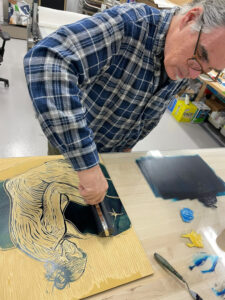
I think right now, my favorite tools are an etching press and a brayer. It’s what I find myself using most. I do love the carving of a linoleum block, but I think that the magic happens in the application of ink, and transferring that to paper.
Do you use a sketchbook?
Absolutely. I try to map out my jumping-on place with drawing. I draw a lot. It’s important for me to figure out what I’m doing in a pencil sketch. That said, the body of paintings I have at my studio now, they’re as improvisational as the prints I’m doing. It would be impossible for me to put them in a sketch book ahead of time. Ninety-nine percent of the time, my sketch book is for me. It’s really personal, and I’m probably the only one who could understand it — even if you could say, Oh, that’s a tree, or a person. It represents me making sense to myself of form.
When did you commit to working with serious intent?
About 30 years ago. As far as the direction I’m going now, I realized I had to put the time in instead of fitting the work in between other stuff. I consider myself fortunate to have crafted the other projects I’ve done have always been art-centered, whether I was the art director or the graphic designer, that sort of thing. I was always on the art side of things. I’ve been fortunate to have work outside of painting. I did realize that some of those things were a distraction [from his studio practice]. So I put them aside.
What role does social media play in your practice?
I share my work often on social media. I’m careful though to not post too much work that’s not finished or is only half-way there — the reason I put it out there maybe because I think it’s cool, and I get positive reinforcement, but then it can be really hard to work on it more. It derails me somehow.
What do you believe is the visual artist’s/creative practitioner’s role in the world?

I know there’s a lot of ugliness out there, and it can be depressing, but I’m an optimist. There is so much beautiful stuff, and peacefulness that’s overlooked, not seen by anybody. If I can bring some of that peace and beauty that I purposely search for, and bring that into this other realm — the gallery, somebody’s home — I think that’s what my goal, my calling might be. A lot of artists have a narrative that’s obvious — it’s religious, it’s political, whatever that might be — I’ve struggled with that thing over the last few years — wondering if I ought to have a more cohesive narrative for my work, which isn’t one that’s so easy to verbalize, but it’s one that resonates with people when they see it.
Did you know anyone, when you were growing up, who had a serious creative practice?
No. I had really supportive and creative parents. My mother painted a lot, and my father played music, and they took us to lots of museums and symphonies. So, I had this exposure; but at the same time, I never knew that being an artist in my day and age was possible.
How did you figure that out?

Who has had the greatest and most lasting influence on your work and practice?
Tenacity.
Is that a guy?
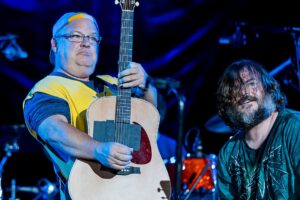
What drives your impulse to make?
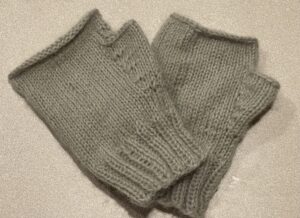
It’s a problem to solve, and the problem is to see something brand new. I just want to see something I’ve never seen before. . It’s really exciting when I can see a glimmer of that. I’m not always successful. I’m not interested in trying to paint like whomever I saw in a museum or gallery. I’ve been having this discussion because in November I started knitting. And that’s making. I’m so fascinated by the simplicity of these two stitches — knit and purl — and I can make a hat, or hand warmers, and a scarf. It’s so simple: two sticks and yarn, and you can make something.
To whom do you go when you need honest feedback about your work?
In general terms, everybody should find someone who knows their work that will be objective with them. Your mom will tell you it’s great regardless. When it comes down to honest feedback, I need to turn to other artist who I trust, I admire, who don’t really gain from telling me it’s good when it’s not.
What’s the role of exhibiting in your practice?

While I’m a non-performative person, I am relatively comfortable talking to people and being in front of a group — but I recognize the need to have my work seen. It’s super important to have that feedback — not the feedback of [social media] a thumbs up or likes; but having somebody respond to it in a personal way — my work made them think of something they hadn’t thought of. Then, I know I’m communicating. It’s nice to sell work, too.
Talk about the ways your teaching activities cross-pollinate with your studio practice. Do the two feed one another?
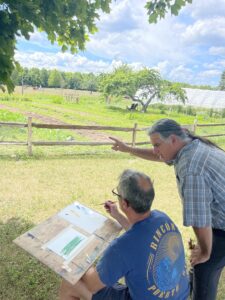
A lot. Definitely. The way that I teach is not technique-based. If somebody wants to know how to mix colors or how do I paint a bird, we can talk about the technical aspects of it; but I’m a big believer in the want to make, and then the necessary facility will come. . What I needed more, and how I give my students a new way to see, or a new in-road to a problem. It’s much more about feeding your creativity, and what you need to do to have ideas flow. What do you need to be told to give yourself permission to go for it? So many people I work with want to, and keep telling themselves they can’t. One-hundred percent of the time there’s something in what they did that’s better than admirable, but they can’t see it. There’s one part of it that’s wrong, and they’re right that it’s wrong, but they don’t see the other 80 percent of it that is pretty terrific, so let’s focus on that.
Do those questions come out of your own practice?
Yes. If I was going to give away the secrets to my teaching technique it’s that I don’t tell my students anything I don’t do on a daily basis. Exactly how I go about it, from the very beginning seed of an idea. And that sometimes I go sit on the beach for a couple hours and just look. It isn’t always best to beat-yourself-up-in-the studio. Everything is inspiring and everywhere.
You’d don’t close yourself off to possibilities.
No. I’m probably a little too open. I run into a lot of walls, but I do tend to run after ideas and whims. Sometimes when you do that you find a cool little trail nobody ever knew about.
Read more about Royce Deans here.
Sarah Bearup-Neal develops and curates Glen Arbor Arts Center exhibitions. She maintains a studio practice focused on fiber and collage.
